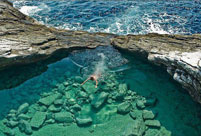 6 Chinese nurses win Florence Nightingale Medal
6 Chinese nurses win Florence Nightingale Medal
 Lady of mystery: Female SWAT team in prison disclosed
Lady of mystery: Female SWAT team in prison disclosed
 Tibetan ethnic costumes presented during tourism festival in NW China
Tibetan ethnic costumes presented during tourism festival in NW China
 Weekly selection of world photos (Aug.19-Aug.24)
Weekly selection of world photos (Aug.19-Aug.24)
 Boy pushed to air, 2 meters high by fountain in Huibei
Boy pushed to air, 2 meters high by fountain in Huibei
 Vintage cars exhibited at auto cultural festival in China's Shanxi
Vintage cars exhibited at auto cultural festival in China's Shanxi
 Military plane crashes in NE China
Military plane crashes in NE China
 Baby born to save his sister - the story of a savior sibling
Baby born to save his sister - the story of a savior sibling
 Those embarrassing copycat buildings
Those embarrassing copycat buildings
Artists tend to show their understanding of the world on canvas or papers with oil, ink or even a chalk, but Lin Hanbing, a Chinese painter, has his own stuff: fish bones.
In his hands, the bony structure discarded by gourmets is turned into elaborate landscapes and works of art at a gallery in the coastal city of Xiamen in east China's Fujian Province.
Born in the neighboring city of Zhangzhou in 1964, Lin moved to Xiamen later. After graduating from an arts and crafts institute in 1989, he began to explore a method of arranging fish bones to make art.
"I get a special feeling with fish bones. They're beautiful, with shapes like the strokes of ancient Chinese calligraphy, which is primitive and elegant," said Lin, who is also the curator of the Oriental Fish Bone Gallery, the first of its kind in the country, located on Gulangyu Island.
Established in April 2006, the gallery now exhibits more than 100 works of fish bone art, which were selected by Lin from over 1,000 of his own creations.
"It was difficult at first. I had to live on borrowing from friends and relatives and my colleagues didn't understand me, but I believed I could invent a new kind of art and a new kind of pleasure," Lin said, "Now I think what I've done over the past 20 years is worth it."
Lin never throws away fish bones after meals because he uses the bones as raw material. He often spends a large amount of money buying rare fish to get distinctive bones. Another way he collects fish bone is to retrieve food waste from restaurants, hotels and residential communities.
"Those are free, but I have to spend a lot of money and time processing them," Lin said.
Before he draws paintings, he has to clean, whiten, embalm and dry those fish bones, which are different in shape and color.
Lin's art has been accepted by a growing number of people. Now, his small gallery receives about 100 visitors every day, with a ticket priced at 20 yuan.
In recent years, Lin has changed his style from original landscape paintings to artwork that reflects environmental problems, including air, river, and sea pollution.
Despite his fast-growing reputation, he worries that there will be nobody to continue his work.
Lin said he has recruited students in the past, but all of them left because they didn't want to spend a long time studying a new art form, and it wasn't likely to bring them huge fortunes.
Lin plans to recruit 10 apprentices nationwide who really like fish bone art and are willing to develop the art form. He said he dreams of building an oceanic cultural art exhibition in the future to introduce oceanic knowledge, fish species, fisherman culture and fish bone art to people around the world.
 August Full Moon celebrated across Greece
August Full Moon celebrated across Greece Top 10 Chinese provinces for the well-heeled
Top 10 Chinese provinces for the well-heeled  Fan Bingbing poses for Malaysian magazine Citta Bella
Fan Bingbing poses for Malaysian magazine Citta Bella Fairytale destinations around world
Fairytale destinations around world Wild dream: Hell-like training for bodyguard
Wild dream: Hell-like training for bodyguard  Zhang Xinyi covers COSMOPOLITAN
Zhang Xinyi covers COSMOPOLITAN China’s weekly story
China’s weekly story  The story of a savior sibling
The story of a savior sibling A collection of bizarre rooftop buildings around China
A collection of bizarre rooftop buildings around China 100th birthday of 'Little Mermaid'
100th birthday of 'Little Mermaid' Escort taskforce holds live-fire training
Escort taskforce holds live-fire training Death toll climbs to 76 in flood of NE China's Fushun
Death toll climbs to 76 in flood of NE China's Fushun Nokia's Global Headquarters: visiting a declining empire
Nokia's Global Headquarters: visiting a declining empire 2013 Taiwan Int'l Tourism Expo kicks off in Taipei
2013 Taiwan Int'l Tourism Expo kicks off in Taipei Photo story: Take a gap year
Photo story: Take a gap yearDay|Week|Month